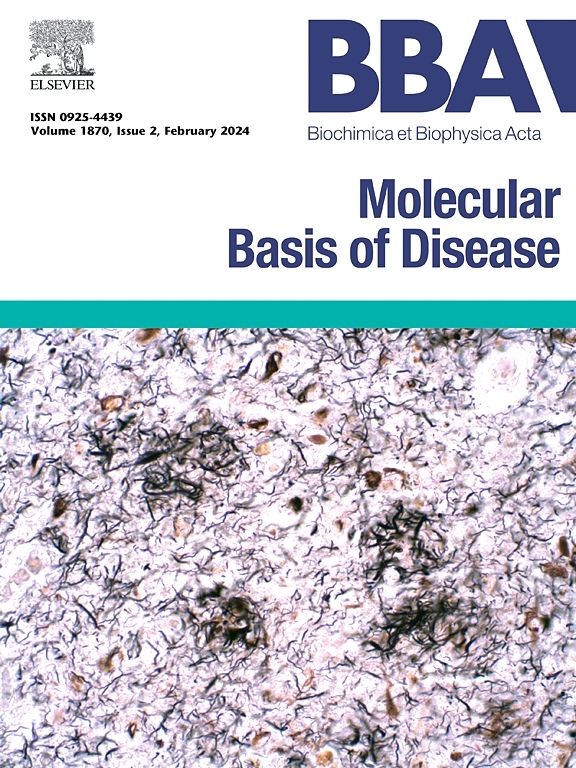PAX6小眼症和无虹膜患者衍生的hiPSC光学杯状器官中notch信号的变异特异性中断
IF 4.2
2区 生物学
Q2 BIOCHEMISTRY & MOLECULAR BIOLOGY
Biochimica et biophysica acta. Molecular basis of disease
Pub Date : 2025-04-23
DOI:10.1016/j.bbadis.2025.167869
引用次数: 0
摘要
含有同源盒的转录因子PAX6是眼睛发育的关键调控因子。致病性杂合PAX6变异导致可变的眼部表型,最常见的是单倍体不足引起的无虹膜。错义变异通常与较轻的眼部疾病相关,尽管dna结合配对结构域的变异会改变靶标结合,导致严重的眼部表型,包括双侧小眼症,类似于sox2 -眼失综合征。然而,变异特异性通路的破坏导致表型异质性尚不清楚。为了研究PAX6变异的致病机制,对hiPSC衍生的3D视杯样器官进行了转录组学和染色质可及性分析,这些器官来自变异(i) PAX6N124K,表现为联合小眼、无虹膜和视神经缺损,以及(ii) PAX6R261X,表现为典型无虹膜。总RNA测序分析显示,与野生型和PAX6R261X单倍不足无虹膜对照相比,错义PAX6N124K杯中SOX2表达下调,Notch信号成分和增殖分化标记也下调。通过ATACseq足迹分析,也发现notch相关基因的转录因子结合基序在PAX6N124K杯中存在差异结合。我们使用体外模型对pax6相关眼病进行了分析,发现DNA结合紊乱会干扰SOX2和Notch信号,导致配对结构域发生错义改变的患者出现严重的眼部表型。这项工作揭示了PAX6在早期眼发生过程中SOX2和Notch信号调节中的先前未确定的作用,以及阐明了变异特异性眼表型和基因型-表型相关性的疾病机制。这些新颖的见解可以影响临床护理,并为潜在的治疗靶点提供有价值的数据,这可以指导未来的转化研究。本文章由计算机程序翻译,如有差异,请以英文原文为准。

Variant-specific disruption to notch signalling in PAX6 microphthalmia and aniridia patient-derived hiPSC optic cup-like organoids
The homeobox-containing transcription factor PAX6 is a key regulator of eye development. Pathogenic heterozygous PAX6 variants lead to variable ocular phenotypes, most commonly haploinsufficiency-induced aniridia. Missense variants are typically associated with milder ocular conditions, although variants in the DNA-binding paired domain which alter target binding lead to severe ocular phenotypes including bilateral microphthalmia, similar to SOX2-anophthalmia syndrome. However, the variant-specific pathway disruption resulting in phenotypic heterogeneity is not well understood. To investigate pathogenic mechanisms of PAX6 variants, transcriptomic and chromatin accessibility analysis was performed on hiPSC derived 3D optic cup-like organoids generated from patients with variants (i) PAX6N124K displaying combined microphthalmia, aniridia and optic nerve coloboma, and (ii) PAX6R261X exhibiting typical aniridia. Total RNA sequencing analysis revealed downregulation of SOX2 in missense PAX6N124K cups compared to both wildtype and PAX6R261X haploinsufficient aniridia controls, along with Notch signalling components and markers of proliferation and differentiation. Transcription factor binding motifs of Notch-related genes were also found to be differentially bound in PAX6N124K cups through ATACseq footprinting analysis. Our analysis of PAX6-related oculopathies using in vitro models reveals disruption to DNA binding perturbs SOX2 and Notch signalling, contributing to severe ocular phenotypes in patients with missense changes in the paired domain. This work reveals a previously unestablished role for PAX6 in SOX2 and Notch signalling regulation during early oculogenesis, as well as illuminating disease mechanisms underlying variant-specific ocular phenotypes and genotype-phenotype correlations. These novel insights can influence clinical care, and provide valuable data on potential therapeutic targets, which can guide future translational research.
求助全文
通过发布文献求助,成功后即可免费获取论文全文。
去求助
来源期刊
CiteScore
12.30
自引率
0.00%
发文量
218
审稿时长
32 days
期刊介绍:
BBA Molecular Basis of Disease addresses the biochemistry and molecular genetics of disease processes and models of human disease. This journal covers aspects of aging, cancer, metabolic-, neurological-, and immunological-based disease. Manuscripts focused on using animal models to elucidate biochemical and mechanistic insight in each of these conditions, are particularly encouraged. Manuscripts should emphasize the underlying mechanisms of disease pathways and provide novel contributions to the understanding and/or treatment of these disorders. Highly descriptive and method development submissions may be declined without full review. The submission of uninvited reviews to BBA - Molecular Basis of Disease is strongly discouraged, and any such uninvited review should be accompanied by a coverletter outlining the compelling reasons why the review should be considered.

 求助内容:
求助内容: 应助结果提醒方式:
应助结果提醒方式:


